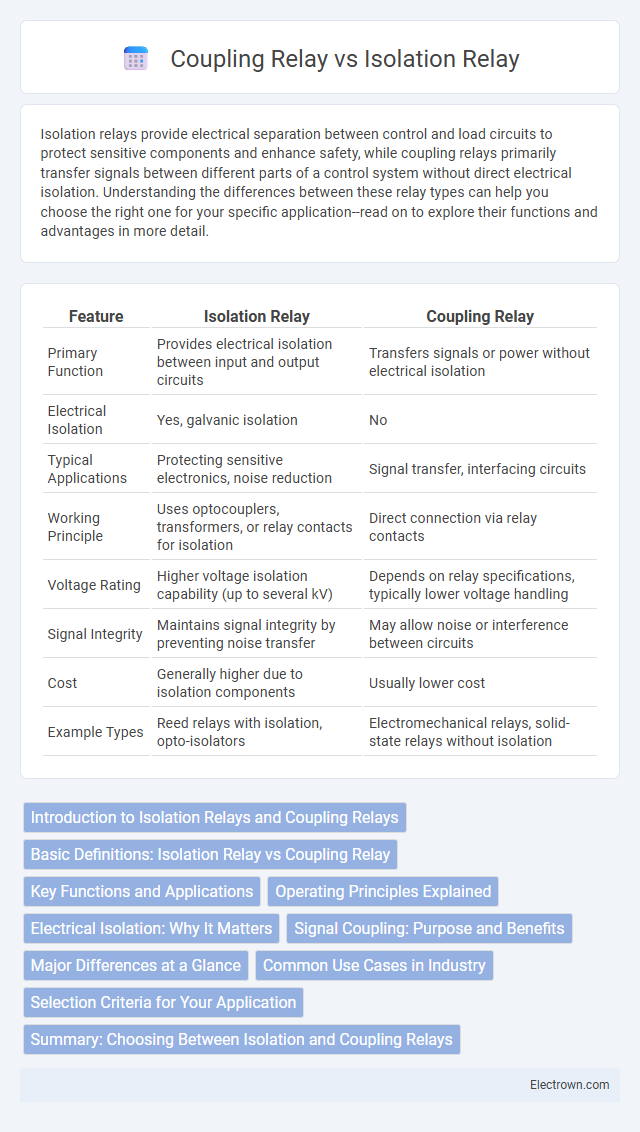Isolation relays provide electrical separation between control and load circuits to protect sensitive components and enhance safety, while coupling relays primarily transfer signals between different parts of a control system without direct electrical isolation. Understanding the differences between these relay types can help you choose the right one for your specific application--read on to explore their functions and advantages in more detail.
Table of Comparison
| Feature | Isolation Relay | Coupling Relay |
|---|---|---|
| Primary Function | Provides electrical isolation between input and output circuits | Transfers signals or power without electrical isolation |
| Electrical Isolation | Yes, galvanic isolation | No |
| Typical Applications | Protecting sensitive electronics, noise reduction | Signal transfer, interfacing circuits |
| Working Principle | Uses optocouplers, transformers, or relay contacts for isolation | Direct connection via relay contacts |
| Voltage Rating | Higher voltage isolation capability (up to several kV) | Depends on relay specifications, typically lower voltage handling |
| Signal Integrity | Maintains signal integrity by preventing noise transfer | May allow noise or interference between circuits |
| Cost | Generally higher due to isolation components | Usually lower cost |
| Example Types | Reed relays with isolation, opto-isolators | Electromechanical relays, solid-state relays without isolation |
Introduction to Isolation Relays and Coupling Relays
Isolation relays provide electrical separation between control and power circuits, enhancing safety by preventing direct electrical contact and minimizing interference. Coupling relays primarily transmit signals between circuits, allowing low-power control signals to operate higher-power devices without electrical isolation. Both relay types play critical roles in protecting sensitive components and ensuring reliable operation in industrial automation systems.
Basic Definitions: Isolation Relay vs Coupling Relay
An isolation relay is designed to separate and protect different circuits by preventing direct electrical connection, ensuring safety and signal integrity. A coupling relay, on the other hand, facilitates the transfer of signals or power between circuits without interruption, maintaining continuous operation. Your choice between isolation and coupling relay depends on whether electrical separation or seamless connectivity is the priority in your application.
Key Functions and Applications
Isolation relays provide electrical separation between control and load circuits, preventing interference and protecting sensitive components, making them ideal for signal isolation in industrial automation and communication systems. Coupling relays, on the other hand, transfer signals or power between circuits without electrical isolation, primarily used to link different parts of a system for synchronized control in applications like motor starters and PLC interfaces. Your choice depends on whether electrical isolation or signal transmission is critical for your specific control system needs.
Operating Principles Explained
Isolation relays operate by physically separating the control circuit from the power circuit using an electromechanical or solid-state barrier to prevent interference and ensure safe signal transmission. Coupling relays function by transferring signals between different parts of a system through electromagnetic induction or semiconductor switching without direct electrical connection. Understanding these operating principles helps you select the right relay type for applications requiring signal integrity and circuit protection.
Electrical Isolation: Why It Matters
Isolation relays provide complete electrical separation between input and output circuits, preventing noise, surges, and voltage spikes from damaging sensitive components. Coupling relays transfer signals with minimal isolation, risking interference and potential component failure in your system. Ensuring proper electrical isolation with isolation relays enhances safety, reliability, and performance in critical applications.
Signal Coupling: Purpose and Benefits
Isolation relays provide electrical separation between control and load circuits, preventing interference and enhancing safety by avoiding direct current flow. Coupling relays enable signal transmission between different circuit elements, ensuring seamless communication and reducing signal degradation. Your selection depends on whether the goal is to protect circuitry or to facilitate signal transfer within automation systems.
Major Differences at a Glance
Isolation relays provide electrical separation between input and output circuits, preventing direct current flow and protecting sensitive components from voltage spikes. Coupling relays primarily serve to transmit signals or power between circuits without significant electrical isolation, enabling control over high power devices using low power signals. Major differences include isolation relays' emphasis on safety and noise reduction, while coupling relays focus on signal transfer and compatibility between different circuit parts.
Common Use Cases in Industry
Isolation relays are commonly used in industrial automation systems to protect sensitive control circuits from high voltage spikes and electrical noise, ensuring reliable signal transmission between different voltage domains. Coupling relays serve primarily in signal interfacing applications, enabling communication between devices with different voltage levels or signaling standards, often found in motor control centers and programmable logic controller (PLC) interfaces. Both relay types enhance operational safety and signal integrity in manufacturing plants, power distribution systems, and process control environments.
Selection Criteria for Your Application
Isolation relays are ideal for applications requiring galvanic separation to prevent signal interference and protect sensitive components, especially in low-voltage control circuits and medical equipment. Coupling relays suit situations needing signal amplification or level shifting without full isolation, commonly used in industrial automation and communication interfaces. Selecting the right relay depends on voltage levels, isolation requirements, switching speed, and environmental factors like electrical noise and temperature tolerance.
Summary: Choosing Between Isolation and Coupling Relays
Isolation relays provide electrical separation between control and load circuits, enhancing safety and preventing signal interference, while coupling relays are designed to connect and synchronize multiple circuits for coordinated operation. Your choice depends on whether you need to protect sensitive equipment from voltage spikes and noise or facilitate communication and control among interconnected systems. Understanding the specific application requirements and environmental conditions is crucial for selecting the right relay type.
isolation relay vs coupling relay Infographic

 electrown.com
electrown.com